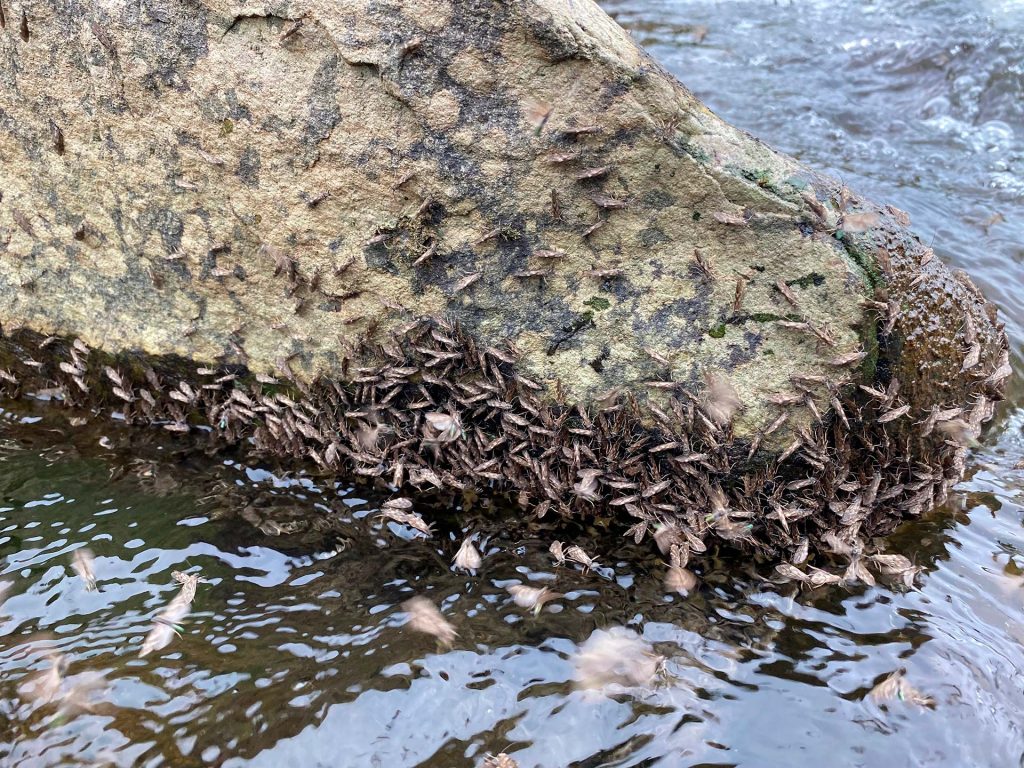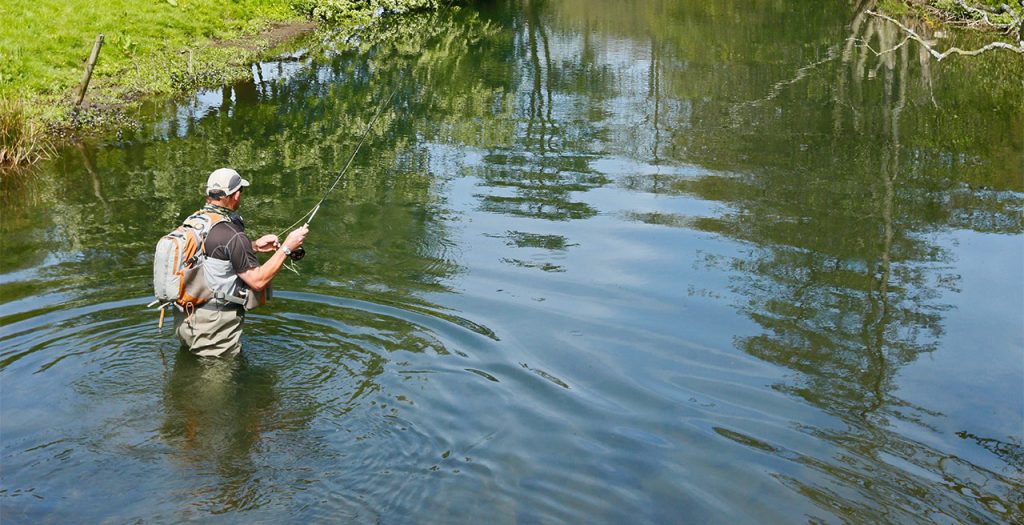12 summer fly fishing tips for river trout
These expert summer fly fishing tips will help you navigate long, unpredictable days on the river — from early starts to choosing flies and finding trout in the right water.
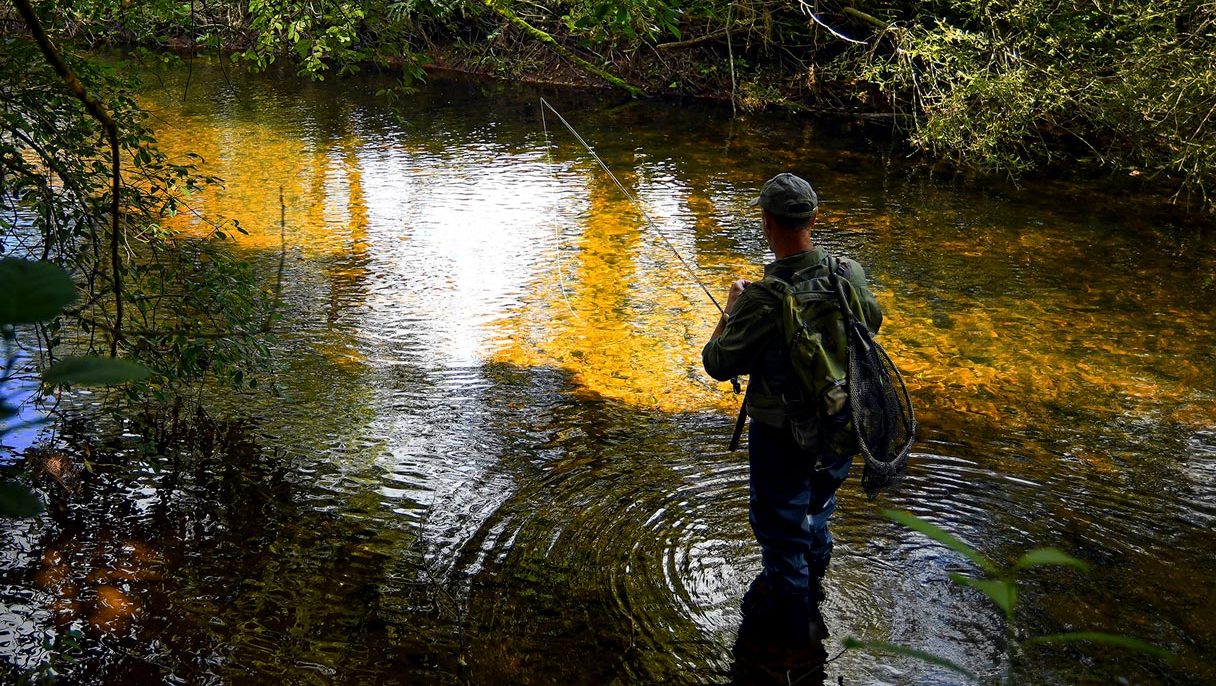
Our summers are longer and less predictable. Longer because the traditional meteorological autumn of September to November seems to have shrunk to a few weeks of leaf fall. Unpredictable because summers could bring a month of record rain or record heat. One thing’s for sure, it won’t be moderate. The challenge for fly-fishers is to adapt. Long summer days spent exploring the wildness flourishing in rivers, even urban streams, are one of our great pleasures. What follows is a miscellany of essential summer fly fishing tips that might make your hot-weather trips more enjoyable — and more successful.
1. Walk the extra mile
Well, that pool looks inviting and you saw a fish rise just above the willow on the far bank the moment you hopped over the stile from the car park. You’re brimful of anticipation. Time to unship your fly?
Not so fast.
Look closely. Among the willow tresses kissing the water is broken tippet lost by previous fishermen. And bootprints in the shallows tell of frequent casts, too. The fish lying there will treat your fly with disdain. A public car park or layby may also attract swimmers or picnickers. Move on!
It takes willpower to take the path less travelled, to clamber through waspish nettles and tumble over fences, but doing so is one of the best summer fly fishing tips for escaping pressured water. You are more likely to find bolder fish that haven’t seen an Adams or an F Fly, especially on a wild stretch of water.
Aim to reach a beat limit and then walk back to the car, or if you’re fishing with a companion, park their car upstream, so you won’t face the trudge back.
2. Smart summer fly fishing tip: dip your elbow first
Water contains less dissolved oxygen when its temperature exceeds 20 deg C, at which point fish will struggle to survive being caught. You can safely fish when the temperature is below 18 deg C, although always play trout quickly and keep them wet when unhooking. A bit like dipping your elbow in the bath before you wash a baby, it is a good idea to carry a thermometer to check that you’re fishing ethically.
3 The 81 rule
Don Stazicker, one of the best thinkers in our sport, once memorably explained in T&S how to sharpen your approach to finding fish using statistics. He explained, “It’s said that 10% of the water holds 90% of the fish. Watching that 10% instead of indiscriminately scanning the whole river makes you nine times more likely to spot a trout.
“Actually, the odds are much more in your favour. If there are ten fish in the river there will be nine fish in the 10% and only one fish in the remaining 90%. Cast to the right 10% and nine fish will see your fly; cast to any other 10% section of the river and 1/9th of a fish will see your fly.
Identifying and fishing the right 10% of the water improves your chances by a factor of 81. This is the number-one reason why a few fishermen catch most of the fish; they know where to look and where to cast.”
Don’s 81 Rule is among the smartest summer fly fishing tips you’ll hear, and he went on to identify the likely holding water, explaining that trout require protection from the current and predators (deep water, undercut banks, tree roots) as well as sufficient dissolved oxygen, especially in summer, and food. Find a place that ticks all four boxes and you will find the fish.
4. Splash!
In summer, manna often falls noisily from the sky: flying ants, windblown heather flies, assorted beetles and crane flies making a commotion on the surface. Ripples will extend from a skittering sedge, too. It all signals food to the trout and that you may want to cause a brouhaha with your fly presentation. Land your beetle or ant pattern with a plop with a pile cast, tweak your fly an inch here, three inches there. Wait for a lunging take.
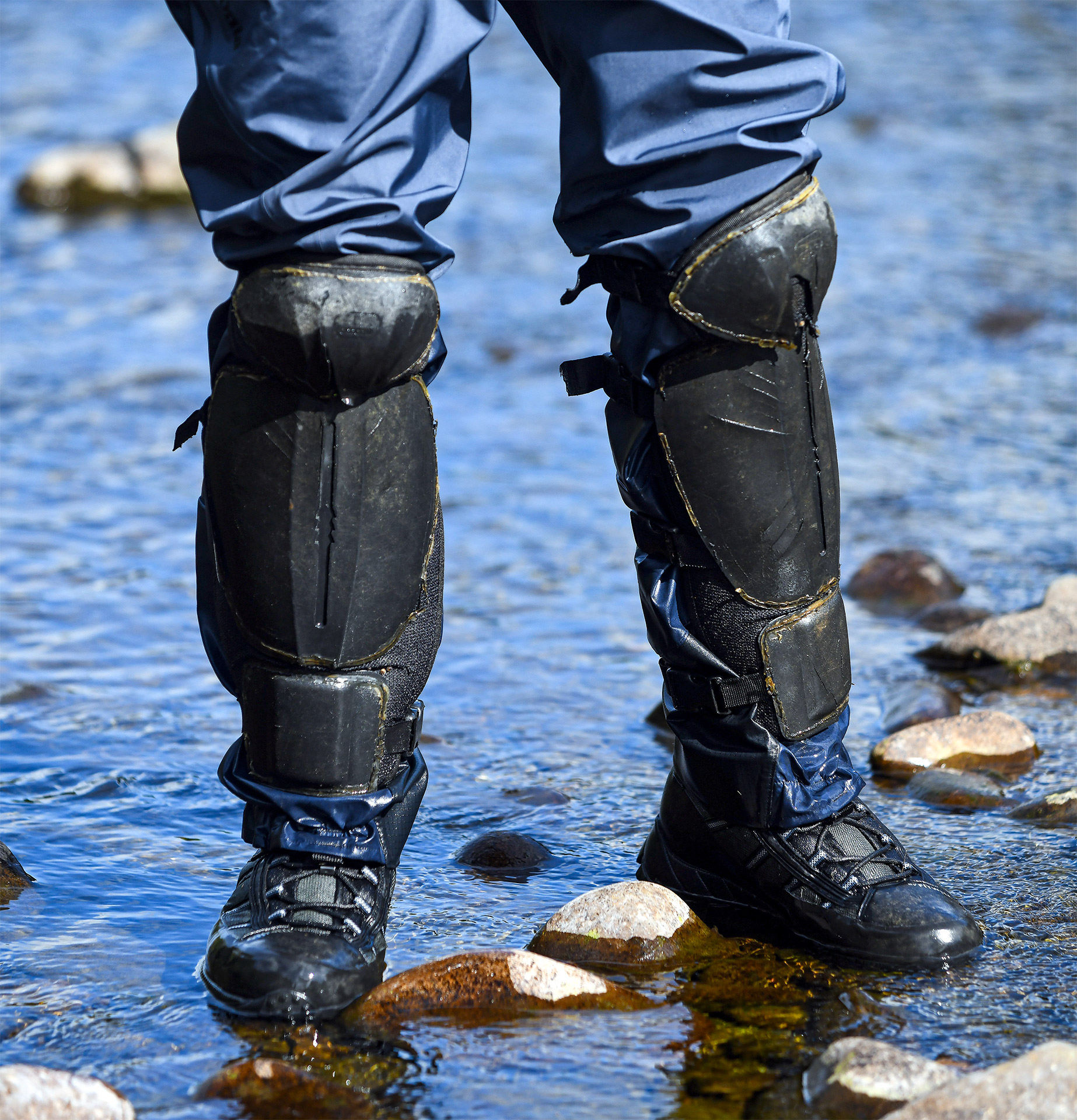
5. Wading wear
Breathable chest waders are a must in warm weather, preferably with the option to roll the chest section down and strap it around the waist.
A collapsible wading staff is essential in rocky pools. They are light and can be folded into a pouch on a wader belt.
You may not need waders if the river is on its bones. Wellingtons or thigh waders with quick-drying tough fishing trousers will be fine or try wet-wading boots (eg Orvis) if the streambed isn’t too lumpy.
Knee pads (pictured) are useful when crouching and kneeling as you approach fish in low water.
6. Up before the larks
In a hot summer, fishing before breakfast, on the riverbank before the sun rises, at 4am or 5am, may be your best chance of a trout. It’s when the fish will mop up the spent flies of the previous evening’s hatch. Look in the slack water, along the margins and in the back eddies. Don’t wade, keep low and away from the banks; avoid disturbing the stillness. A caddis pattern will work well.
7. Use your time efficiently when summer fly fishing
During a full day’s sport, it pays to prioritise the when and where. If you walk the length of a beat, log the fish you have seen and then consider…
Should that one behind the rock in Bridge pool be covered now or will you have time to return later? Will it have stopped rising later? Will its lie be better covered when the sun has moved to the west, creating shade? Is the wind forecast to drop or quarter, aiding the direction of your cast? Has the temperature risen and a breeze picked up, prompting a brief hatch of upwings? Are there bigger fish that deserve more of your effort? How long will it take you to walk four or five pools, to a noted spot, and back?
If you don’t know the beat, you won’t know what else is in store, but an awareness of the possibilities may stop you missing out.
8. Tree-hugging
That half-man half-heron, Paul Procter, is a great exploiter of the trout’s appetite for terrestrial insects that fall from trees. When high summer fly fishing, he’ll make a beeline for the treeline if he suspects fish are dining on dunked beetles or greenfly. An overhanging stand of alders or sycamores will offer trout shade from bright sunshine, as well as security among its gnarly tree roots and dark water. Fish may lie within inches of a sheltered bank or beneath branches, so you may have to cast close to trouble and risk losing a fly.
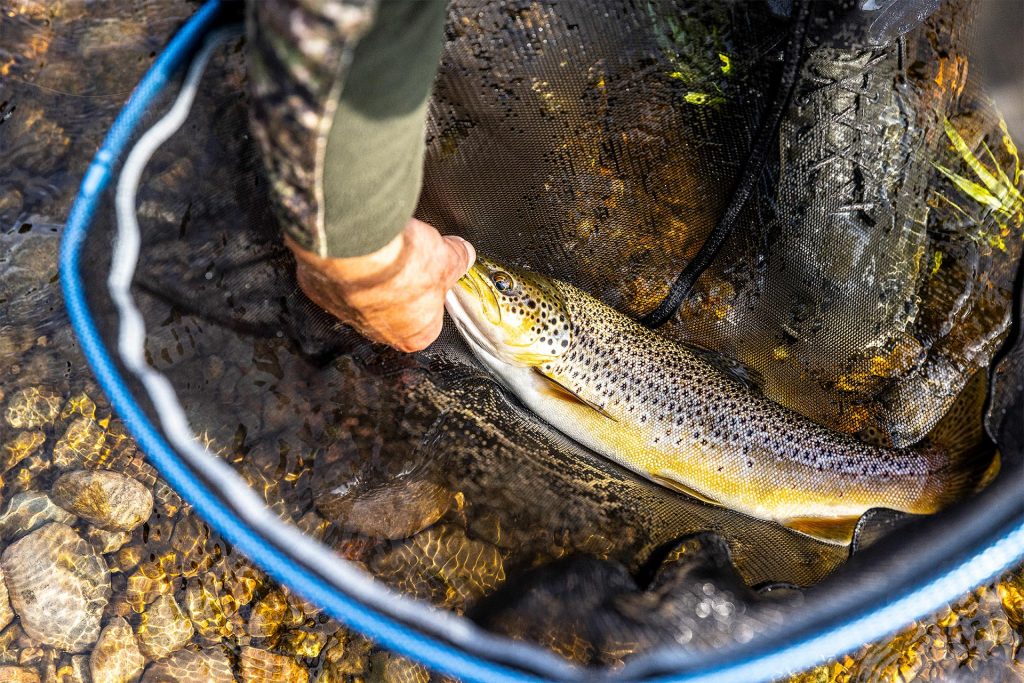
9. Those you leave behind
This is Forrest Gumph’s “Life’s a box of chocolates” dilemma. You never know what the trout will be eating. Yet in the interest of travelling light and to deter indecision, try taking just one box. The discipline of restraint — leaving flies behind — is difficult. However, GISS (General Impression of Size and Shape) patterns will roughly imitate the major fly groups (upwings, sedges and stoneflies) at different life stages (nymph, emerger, adult). Popular GISS flies include Adams, Klinkhåmer, F Fly, Hare’s Ear Nymph, Pheasant Tail Nymph, Shrimp and Elk Hair Caddis — take five of each, different sizes.
After that, be Noah-like: two berths for Daddies, Hoppers, Beetles, Gnats, Bibios, Mayflies, BWOs, Cinnamon Sedges, Ants, Spiders.
Can you do it? Only take 50 flies? Or just 20? That’s the challenge.
10. Pesky blighters
Sometimes in high summer the water’s surface can appear pockmarked with sipping fish, but it is not apparent what fly is being taken. The answer may be reed smuts or gnats. Waterborne smuts may be only 3mm long and windblown gnats just 5mm. A size 18-20 fly is needed to imitate them, so pack magnifiers — these flies are not called Black Curse for nothing.
Trout take the smut when it pupates and ascends in a bubble of air to the surface where it may become trapped. Heed the advice of that Welsh Borders wizard Louis Noble, who recommends a Pearly Smut (pictured below – the pearl rib mimicking the air bubble) for the trapped fly, or any tiny gnat pattern knotted to as fine a leader as you dare, not least to thread the hook eye. Lift into the fish gently to avoid a break.

11. Into the gloom
A fly cast into strongly shaded water can be difficult to see. Using a pattern with a brightly coloured wingpost or one that contrasts with the background will help, as will the duo method where a high-floating dry-fly will signal a take to a smaller nymph. Alter the angle at which you view the fly, crouching low to the surface or slightly to the left and right.
12. A summer fable
The evening rise. It sometimes happens. And sometimes you’ll go stare crazy looking for a non-existent dimple in the murk. If you’re lucky, a muggy evening may summon a blue-winged olive hatch or a spinner fall following an earlier hatch. A size 16 BWO Para Spinner with a fluorescent wingpost is the vigilant Paul Procter’s choice in low evening light.
If the BWOs are having a night off, sedges are more reliable. Trout rising splashily towards them will be obvious and may continue deep into the night. Mimic the skittering movements of the adult caddis by swinging the fly across the current or tweaking it to create a wake. Again it is to Paul Procter that we seek advice, whose patience is often rewarded by deft movement of a buoyant Bushy Elk Hair Caddis in sizes 12 to 16.
Perfect preparation prevents….
To succeed at summer fly fishing on rivers, you should be comfortable. Here’s a short prepper’s checklist of useful kit, especially if fishing alone in remote areas. Other than the water, it’s light and compact, so easy to carry.
Water: insulated bottle or bladder with mouthtube.
Energy food: fruit, nuts, energy bars — chocolate, meat, bread may not stay in good shape in
hot weather.
Roll-top or freezer bags: will keep cameras, keyfobs and phones dry in downpours or after a misstep in the river.
Phone and portable power bank. Also, download the What3words app in case of emergency.
Health kit: sun cream, insect repellent and balm, antiseptic wipes, painkillers, plasters, bandage roll and tape, tick-removal tool.
Waterproof shell top: you may wear it all day, depending on the weather. You may anticipate summer heat, but the day could become very cold and wet.
Fishing is more than just catching
No matter how tough the conditions, you want to catch a trout. That’s a given. But what else do you want to get out of the day? It is easy to become one-dimensional, and if you don’t achieve your end, a little dejected. So, a mental checklist of minor goals can add to the pleasures of summer fly fishing.
- That wonderful angling writer Lawrence Catlow rewards himself with red wine when he catches a brace. The point being: take time out and be satisfied. Snooze under a tree. Have a small picnic.
- Take a picture of the fish you catch and, later, a closer look at its spotting. Compiling a photo library of trout spots is fascinating, especially if you also note where the fish was caught, the riverbed and vegetation that influences its camouflage.
- Five minutes of stone-turning and seine netting will help you build a picture of the type of food in the river and help you match the hatch as well as increasing your wider knowledge for next time.
- Keeping a diary is satisfying, even if you don’t catch anything; it encourages later reflection. Record your day, perhaps taking a few measurements (temperature/pressure) but also adding notes on the flora and fauna you see and people you meet. Either blog (writing on WordPress or Blogger) or use an app like Finscribe.
- Try fishing with a classic or regional pattern, ideally one you’ve tied yourself. It is hugely satisfying to see your own tying of, say, a Beacon Beige or a Lunn’s Particular alight on the water, just as they did for our ancestors.
- Hone your casts, even if for only half an hour. Orvis hosts many instruction videos on YouTube so you can fine-tune the Parachute and Reach on the hoof via your phone. Step away with improved technique.
- Introduce someone to wild river fishing. By leading a memorable adventure for a friend, son or granddaughter, you could encourage a lifelong passion.




